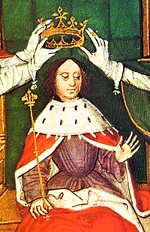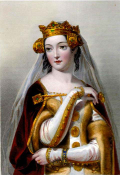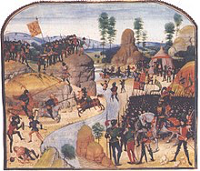King Edward III of England
Part 1: Still Trouble with Scotland Edward III was one of England's longest-ruling monarchs. He was king during the onset of the Hundred Years War and the deadly visitation of the Black Death. Edward was born on Nov. 13, 1312, at Windsor Castle. At the time, his father, King Edward II, was embroiled in a dispute with his nobles. He found time, however, to name his first son Earl of Chester. 
Young Edward grew up against the backdrop of this ongoing struggle between his father and the nobles. Edward went with his mother, Isabella of France, to France in 1325 to help negotiate a peace treaty. Isabella allied herself with Roger Mortimer, a Marcher lord that Edward II had banished, and the pair led an armed invasion of England, resulting in the king's abdication. Young Edward was crowned King Edward III in Westminster Abbey on Feb. 1, 1327. He was 14. 
Edward had been betrothed the year before to Philippa of Hainault, the daughter of a Dutch count. The young couple were married on Jan. 24, 1328, at York Minister. They made their main home Woodstock Palace, in Oxfordshire. Their first son, also named Edward, arrived just days before Philippa turned 16. She went on to have 13 more children. Still a teenager, Edward was technically, but his mother and Mortimer were still regents and effectively running the realm. Edward ordered the pair seized in October 1330. Edward had his mother held at Berkhamsted Castle and then under house arrest for a couple of years. Mortimer was summarily executed. Edward is known for his decadeslong struggle against France, but his first real conflict after taking the throne was against Scotland. His father had certainly not succeeded as well as his father, the "Hammer of the Scots" King Edward I. The Scottish army, under Robert the Bruce had won a stirring victory at Bannockburn in 1314 and then an opportunistic follow-sup at the Battle of Stanhope in 1328. Edward was just recently crowned and had joined the English Army for his first campaign; he was trapped in a collapsed during a night raid by the Scottish forces and nearly captured. The resulting Treaty of Edinburgh-Northampton stipulated England's recognition that Scotland was an independent kingdom. 
That didn't stop the English from continuing to interfere in the rule of Scotland. Robert the Bruce died in 1329 and was succeeded by his son, who became King David II, who was yet another very young monarch. Edward preferred another of his name, Edward Balliol, to be the ruler of Scotland. The son of the unfortunate John Balliol, King Edward Balliol enjoyed support from England but not Scotland. Despite a victory by England's King Edward at Halidon Hill in 1333, Balliol had too little support in the end and David II was eventually able to reclaim his throne. Next page > A Lifetime of War > Page 1, 2, 3 |
|
Social Studies for Kids
copyright 2002–2025
David White




